(完整版)高考英语短文改错介词考点
- 格式:doc
- 大小:28.23 KB
- 文档页数:10
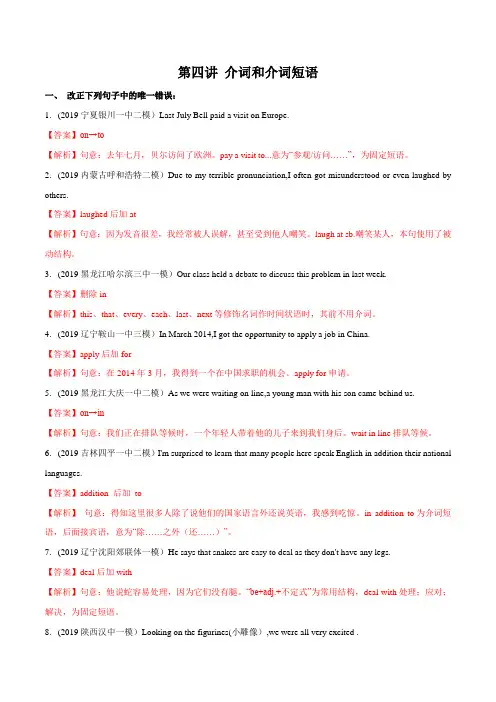
第四讲介词和介词短语一、改正下列句子中的唯一错误:1.(2019宁夏银川一中二模)Last July Bell paid a visit on Europe.【答案】on→to【解析】句意:去年七月,贝尔访问了欧洲。
pay a visit to...意为“参观/访问……”,为固定短语。
2.(2019内蒙古呼和浩特二模)Due to my terrible pronunciation,I often got misunderstood or even laughed by others.【答案】laughed后加at【解析】句意:因为发音很差,我经常被人误解,甚至受到他人嘲笑。
laugh at sb.嘲笑某人,本句使用了被动结构。
3.(2019黑龙江哈尔滨三中一模)Our class held a debate to discuss this problem in last week.【答案】删除in【解析】this、that、every、each、last、next等修饰名词作时间状语时,其前不用介词。
4.(2019辽宁鞍山一中三模)In March 2014,I got the opportunity to apply a job in China.【答案】apply后加for【解析】句意:在2014年3月,我得到一个在中国求职的机会。
apply for申请。
5.(2019黑龙江大庆一中二模)As we were waiting on line,a young man with his son came behind us.【答案】on→in【解析】句意:我们正在排队等候时,一个年轻人带着他的儿子来到我们身后。
wait in line排队等候。
6.(2019吉林四平一中二模)I'm surprised to learn that many people here speak English in addition their national languages.【答案】addition 后加to【解析】句意:得知这里很多人除了说他们的国家语言外还说英语,我感到吃惊。
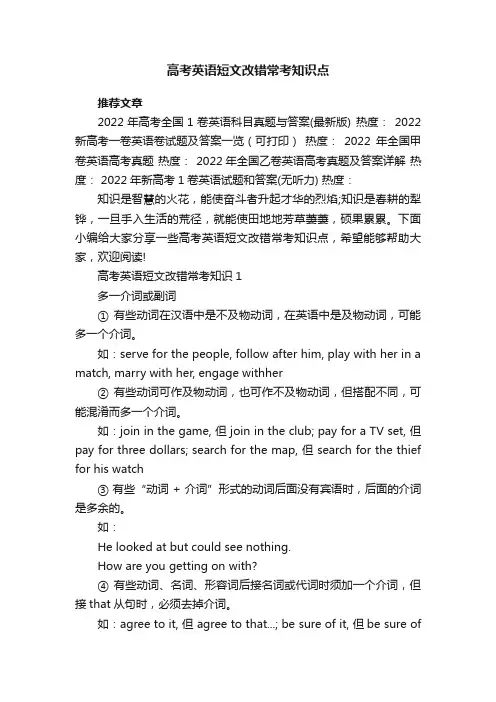
高考英语短文改错常考知识点推荐文章2022年高考全国1卷英语科目真题与答案(最新版) 热度:2022新高考一卷英语卷试题及答案一览(可打印)热度:2022年全国甲卷英语高考真题热度: 2022年全国乙卷英语高考真题及答案详解热度: 2022年新高考1卷英语试题和答案(无听力) 热度:知识是智慧的火花,能使奋斗者升起才华的烈焰;知识是春耕的犁铧,一旦手入生活的荒径,就能使田地地芳草萋萋,硕果累累。
下面小编给大家分享一些高考英语短文改错常考知识点,希望能够帮助大家,欢迎阅读!高考英语短文改错常考知识1多一介词或副词① 有些动词在汉语中是不及物动词,在英语中是及物动词,可能多一个介词。
如:serve for the people, follow after him, play with her in a match, marry with her, engage withher② 有些动词可作及物动词,也可作不及物动词,但搭配不同,可能混淆而多一个介词。
如:join in the game, 但 join in the club; pay for a TV set, 但pay for three dollars; search for the map, 但 search for the thief for his watch③ 有些“动词 + 介词”形式的动词后面没有宾语时,后面的介词是多余的。
如:He looked at but could see nothing.How are you getting on with?④ 有些动词、名词、形容词后接名词或代词时须加一个介词,但接that从句时,必须去掉介词。
如:agree to it, 但 agree to that...; be sure of it, 但be sure ofthat…; be sorry for it, 但be sorry for that…⑤ 有些副词或介词词组后加一个介词,组成了复合介词,若后面没有接宾语时,最后的介词则是多余的。
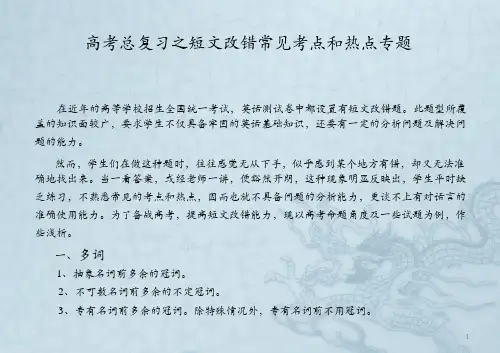
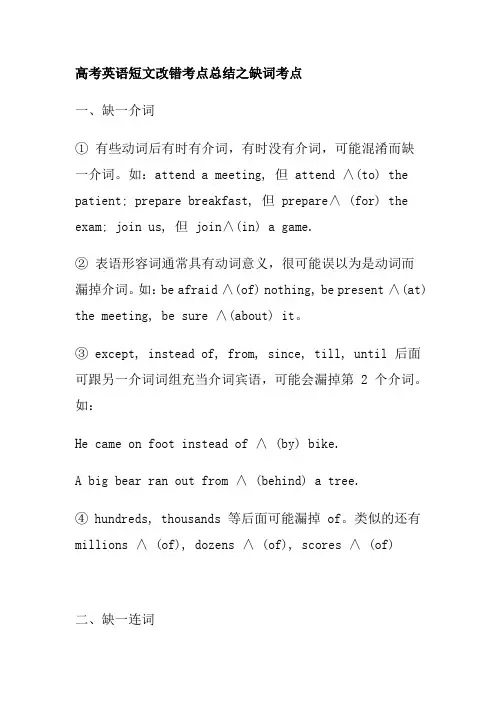
高考英语短文改错考点总结之缺词考点一、缺一介词① 有些动词后有时有介词,有时没有介词,可能混淆而缺一介词。
如:attend a meeting, 但attend ∧(to) the patient; prepare breakfast, 但prepare∧ (for) the exam; join us, 但join∧(in) a game.② 表语形容词通常具有动词意义,很可能误以为是动词而漏掉介词。
如:be afraid ∧(of) nothing, be present ∧(at) the meeting, be sure ∧(about) it。
③ except, instead of, from, since, till, until 后面可跟另一介词词组充当介词宾语,可能会漏掉第 2 个介词。
如:He came on foot instead of ∧ (by) bike.A big bear ran out from ∧ (behind) a tree.④ hundreds, thousands 等后面可能漏掉 of。
类似的还有millions ∧ (of), dozens ∧ (of), scores ∧ (of)二、缺一连词① 汉语常用意合法,分句与分句之间往往不用连词,但英语里不行。
如:It began to rain, ∧ (and) they had to stop the match. (如果中间用分号可不用连词)It was late, ∧ (so) we went home.You like sports, ∧ (while) I’d rather read.He looked for the key, ∧ (but) didn’t find it.② 受汉语影响,并列动词词组之间可能缺一个and。
如:She smiled ∧ (and) said good-bye to her father.③ 名词性从句 that分句置于句首或作同位语时不可缺少连词。
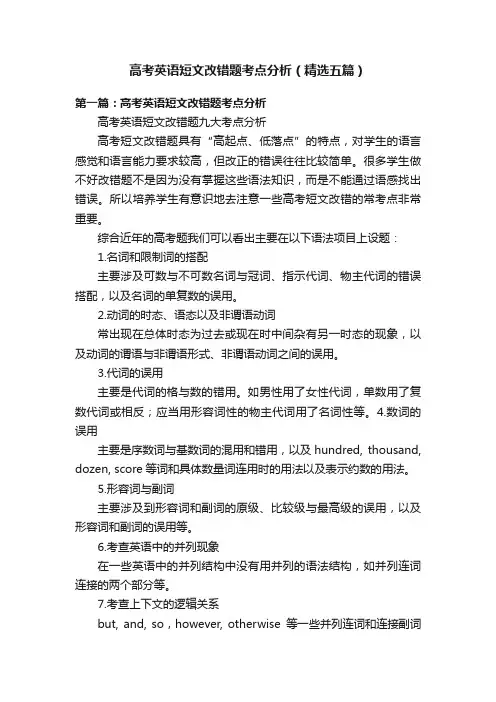
高考英语短文改错题考点分析(精选五篇)第一篇:高考英语短文改错题考点分析高考英语短文改错题九大考点分析高考短文改错题具有“高起点、低落点”的特点,对学生的语言感觉和语言能力要求较高,但改正的错误往往比较简单。
很多学生做不好改错题不是因为没有掌握这些语法知识,而是不能通过语感找出错误。
所以培养学生有意识地去注意一些高考短文改错的常考点非常重要。
综合近年的高考题我们可以看出主要在以下语法项目上设题:1.名词和限制词的搭配主要涉及可数与不可数名词与冠词、指示代词、物主代词的错误搭配,以及名词的单复数的误用。
2.动词的时态、语态以及非谓语动词常出现在总体时态为过去或现在时中间杂有另一时态的现象,以及动词的谓语与非谓语形式、非谓语动词之间的误用。
3.代词的误用主要是代词的格与数的错用。
如男性用了女性代词,单数用了复数代词或相反;应当用形容词性的物主代词用了名词性等。
4.数词的误用主要是序数词与基数词的混用和错用,以及hundred, thousand, dozen, score等词和具体数量词连用时的用法以及表示约数的用法。
5.形容词与副词主要涉及到形容词和副词的原级、比较级与最高级的误用,以及形容词和副词的误用等。
6.考查英语中的并列现象在一些英语中的并列结构中没有用并列的语法结构,如并列连词连接的两个部分等。
7.考查上下文的逻辑关系but, and, so,however, otherwise等一些并列连词和连接副词的误用。
before, after, when, until, since等状语从句引导词的误用等。
还有肯定和否定的误用等。
8.一些相似结构的误用如used to do, be used to do, be used to doing等结构的误用。
9.惯用法的搭配改错步骤上述9个方面,同学们在做题时只要稍加留意,找出错误的比率就会增大很多。
做短文改错题时一般遵循以下几个步骤:1.先通读全文。
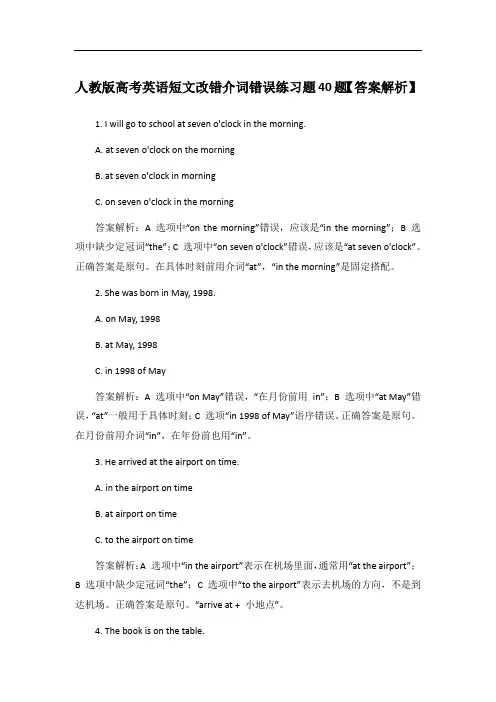
人教版高考英语短文改错介词错误练习题40题【答案解析】1. I will go to school at seven o'clock in the morning.A. at seven o'clock on the morningB. at seven o'clock in morningC. on seven o'clock in the morning答案解析:A 选项中“on the morning”错误,应该是“in the morning”;B 选项中缺少定冠词“the”;C 选项中“on seven o'clock”错误,应该是“at seven o'clock”。
正确答案是原句。
在具体时刻前用介词“at”,“in the morning”是固定搭配。
2. She was born in May, 1998.A. on May, 1998B. at May, 1998C. in 1998 of May答案解析:A 选项中“on May”错误,“在月份前用in”;B 选项中“at May”错误,“at”一般用于具体时刻;C 选项“in 1998 of May”语序错误。
正确答案是原句。
在月份前用介词“in”,在年份前也用“in”。
3. He arrived at the airport on time.A. in the airport on timeB. at airport on timeC. to the airport on time答案解析:A 选项中“in the airport”表示在机场里面,通常用“at the airport”;B 选项中缺少定冠词“the”;C 选项中“to the airport”表示去机场的方向,不是到达机场。
正确答案是原句。
“arrive at + 小地点”。
4. The book is on the table.A. in tableB. at the tableC. under table答案解析:A 选项中“in table”错误,没有这种表达;B 选项“at the table”表示在桌子旁边;C 选项“under table”错误,缺少定冠词“the”。
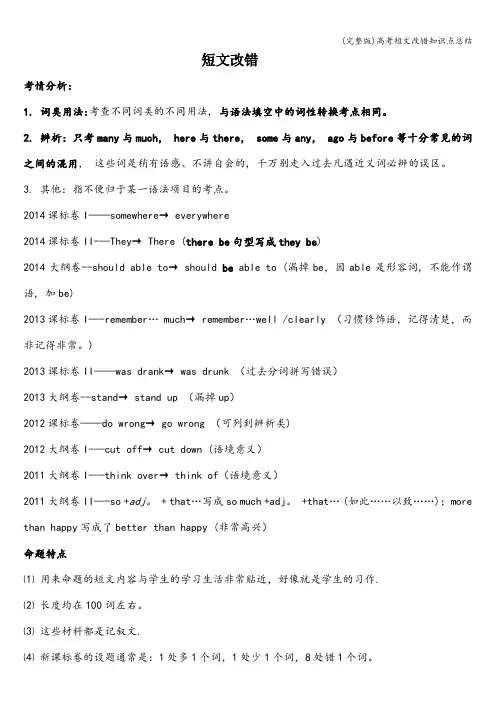
短文改错考情分析:1. 词类用法:考查不同词类的不同用法, 与语法填空中的词性转换考点相同。
2. 辨析:只考many与much, here与there, some与any, ago与before等十分常见的词之间的混用,这些词是稍有语感、不讲自会的, 千万别走入过去凡遇近义词必辨的误区。
3. 其他:指不便归于某一语法项目的考点。
2014课标卷I——somewhere→ everywhere2014课标卷II-—They→ There (there be句型写成they be)2014大纲卷--should able to→ should be able to (漏掉be,因able是形容词, 不能作谓语, 加be)2013课标卷I—-remember… much→remember…well /clearly (习惯修饰语,记得清楚,而非记得非常。
)2013课标卷II——was drank→ was drunk (过去分词拼写错误)2013大纲卷--stand→ stand up (漏掉up)2012课标卷——do wrong→ go wrong (可列到辨析类)2012大纲卷I-—cut off→ cut down (语境意义)2011大纲卷I—-think over→ think of(语境意义)2011大纲卷II—-so +adj。
+ that…写成so much +adj。
+that… (如此……以致……);more than happy写成了better than happy (非常高兴)命题特点⑴用来命题的短文内容与学生的学习生活非常贴近,好像就是学生的习作.⑵长度均在100词左右。
⑶这些材料都是记叙文.⑷新课标卷的设题通常是:1处多1个词,1处少1个词,8处错1个词。
5. 要求考生添加或删除的词通常是虚词.⑴少了一个词,要求添加的词有:①冠词:in countryside →in the countryside(2015课标I)As result→ As a result(2014课标I)②介词:listening music→ listening to music(2014课标II)③连词:He had…, he was… →He had…, and he was(2013课标I)④不定式符号:came see me→ came to see me(2007课标)⑤物主代词:Tom saw parents→ Tom saw his parents(2015课标II)⑵多了一个词,要求删除的词有:介词、冠词、连词、助动词、不定式符号to。

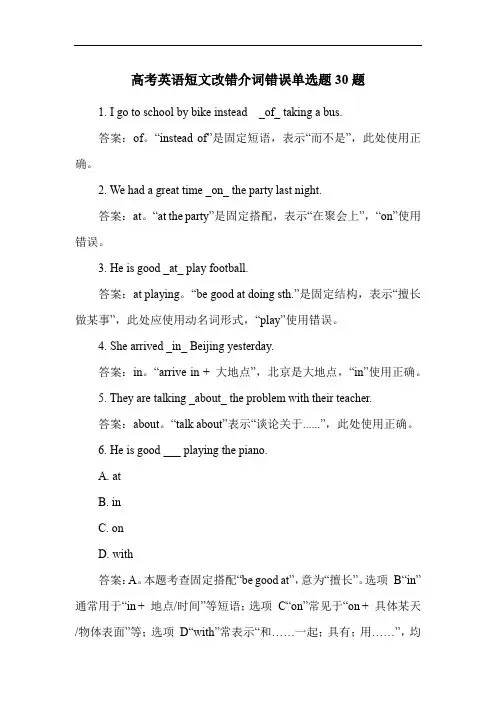
高考英语短文改错介词错误单选题30题1. I go to school by bike instead _of_ taking a bus.答案:of。
“instead of”是固定短语,表示“而不是”,此处使用正确。
2. We had a great time _on_ the party last night.答案:at。
“at the party”是固定搭配,表示“在聚会上”,“on”使用错误。
3. He is good _at_ play football.答案:at playing。
“be good at doing sth.”是固定结构,表示“擅长做某事”,此处应使用动名词形式,“play”使用错误。
4. She arrived _in_ Beijing yesterday.答案:in。
“arrive in + 大地点”,北京是大地点,“in”使用正确。
5. They are talking _about_ the problem with their teacher.答案:about。
“talk about”表示“谈论关于......”,此处使用正确。
6. He is good ___ playing the piano.A. atB. inC. onD. with答案:A。
本题考查固定搭配“be good at”,意为“擅长”。
选项B“in”通常用于“in + 地点/时间”等短语;选项C“on”常见于“on + 具体某天/物体表面”等;选项D“with”常表示“和……一起;具有;用……”,均不符合“擅长”的意思。
7. They arrived ___ Beijing last night.A. inB. atC. onD. to答案:A。
“arrive in + 大地点”,“arrive at + 小地点”,北京是大地点,所以用“in”。
选项B“at”用于小地点;选项C“on”通常用于“在……上面”;选项D“to”一般表示“到……”,不符合到达某地的表达。
![高考英语短文改错考点归纳[课件]](https://uimg.taocdn.com/e2c8aa89d15abe23482f4d9c.webp)
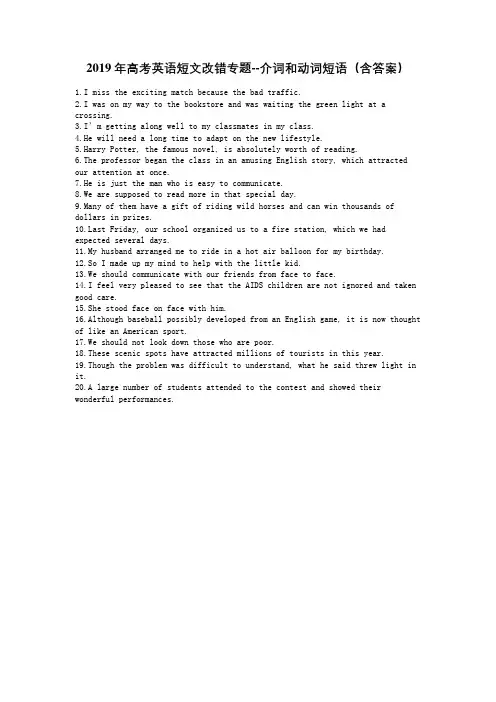
2019年高考英语短文改错专题--介词和动词短语(含答案)1.I miss the exciting match because the bad traffic.2.I was on my way to the bookstore and was waiting the green light at a crossing.3.I’m getting along well to my classmates in my class.4.He will need a long time to adapt on the new lifestyle.5.Harry Potter, the famous novel, is absolutely worth of reading.6.The professor began the class in an amusing English story, which attracted our attention at once.7.He is just the man who is easy to communicate.8.We are supposed to read more in that special day.9.Many of them have a gift of riding wild horses and can win thousands of dollars in prizes.st Friday, our school organized us to a fire station, which we had expected several days.11.My husband arranged me to ride in a hot air balloon for my birthday.12.So I made up my mind to help with the little kid.13.We should communicate with our friends from face to face.14.I feel very pleased to see that the AIDS children are not ignored and taken good care.15.She stood face on face with him.16.Although baseball possibly developed from an English game, it is now thought of like an American sport.17.We should not look down those who are poor.18.These scenic spots have attracted millions of tourists in this year.19.Though the problem was difficult to understand, what he said threw light in it.20.A large number of students attended to the contest and showed their wonderful performances.参考答案1.答案:I miss the exciting match becauseµof the bad traffic.解析:2.答案:I was on my way to the bookstore and was waiting¶for the green light at a crossing.解析:句意:我在去书店的路上,正在十字路口等绿灯。
高考英语短文改错介词考点 介词是一种用来表示词与词、词与句之间的关系的虚词,在句中不能单独作句子成分。介词后面
一般有名词、代词或相当于名词的其他词类,短语或从句作它的宾语。介词和它的宾语构成介词词组,在句中作状语、表语、定语或宾语补足语。介词可分为时间介词、地点介词、方式介词、原因介词和其他介词。 ①Nothing in the world could live without air or water.(状语) ①This machine is in good condition.(表语) ①Where is the key to my bike?(定语) ①She always thinks herself above others.(宾补) 一、介词的分类 (1)从用法分类 介词类型 例词 例句 表示方位 at, before, behind, below, etc. There must be something behind it.
表示时间 about, after, at, before, by, etc. He came home after 3 days. 表示原因、目的 for, with, from, etc. He died from cancer. 表示对于 to, for, over, at, with, etc. The book is really difficult for me. 表示手段、方式 by, in, with, etc. I will defend the motherland with my life. 表示除去 but, besides, except, etc. We all went to the supermarket except Tom. 表示比较 as, like, above, over, than, etc. They united as one man. 表示结果 to, with, without, etc. Man can’t live without water. (2)从结构分类
介词分类 构成 例词 简单介词 只有单独一个 词的介词 after, at, on, in, during, since, till, across, over, through, past,
near, to, above, by, for, down, from, of, off, behind, below, beneath, beside, between, beyond, up, with, about, against, along, among, around, etc. 复合介词 由两个单词 合成的介词 into, inside, onto, outside, throughout, towards, upon, within,
without, etc.
短语介词 形容词,分词 或副词+介词 according to, away from, down to, inside of, near to, opposite to,
owing to, etc. 连词+介词 as for, as to, because of, etc. 介词+介词(又称双重介词) from among, from behind, from under, till after, in between, etc.
介词+名词+介词 by means of, in front of, in spite of, on account of, with regard to, etc. 其他 thanks to, etc.
由其他词类转用
分词 concerning, considering, including, regarding, etc. 形容词或副词 like, near, opposite, round, next, etc. 连词 than, but(除……之外), etc. 名词 despite(不顾;不管), etc.
【考点一】考查with/without复合结构 介词with/without+名词/代词+形容词/副词/介词短语/动词不定式/分词(分词可以是现在分词,也可以是过去分词)在句中表状态或说明背景情况,常作伴随、方式、原因、条件等状语。 With all the things she needed bought, she went home happily. Possibly this person died without anyone knowing where the coins were hidden. 单项填空 ①It was a pity that the great writer died _____ his works unfinished. A. for B. with C. from D. of 解析:选B。考查with复合结构。works 与unfinish之间为动宾关系,所以用过去分词表示被动。如果名词或代词与后面的动词是主谓关系,则用现在分词表示主动。
【考点二】考查工具、手段、方式介词 (1)by, in, on三词都可表示旅行的方式 ①不涉及交通工具的名词时用by,名词前不加冠词。如by sea, by water, by land, by rail, by air等。 ①涉及交通工具的名词时用by,名词须用单数形式,前面不加冠词或任何修饰语。如by bike, by taxi, by plane, by ship/boat, by train, by spaceship等。 ①当旅行方式涉及确定特指的交通工具时,用on或in,名词前加冠词、物主代词、指示代词等修饰语。如travel to New York in this plane,leave on an early train,go to school on my bike等。 注意:步行、骑马、骑骆驼均用on。如on foot,on horseback,on a horse,on the camel。 (2)with, by, in三词均意为“用”,表示行为的工具、手段或方式。 ①with用于有形的工具或身体某些器官之前,其后的名词多被冠词、物主代词等修饰。 They are digging with a pick/spade. We see with our eyes, hear with our ears, and walk with our legs. ①by, in, on, over, through等介词多用于无形的工具或方式手段之前。如by hand, in ink, on the telephone, over the radio, through the telescope等。 注意: ①使用语言、原料、材料时,用in表示,如in English/Japanese;in blue ink等。 ①表达“用……方法/式”时,所用介词有:in this/that/the same way,by means of,by this/that means,with this/that method等。
【考点三】考查of+抽象名词的用法 “of+抽象名词”的用法与形容词相同,在句中可作表语、定语、补语。 of+great/much +抽象名词=very+名词的形容词形式 of+no+抽象名词=not+名词的形容词形式 It is of great value.=It is very valuable. It is of no use.=It is useless. The camel is of great help to the Arab. =The camel is very helpful to the Arab.
【考点四】考查表示程度的介词by, to, beyond by 表示“增加了……”;to表示“增加到……”;beyond表示“范围, 限度超出”。 This new model of car is so expensive that it is beyond the reach of those with average incomes.
单项填空 ①Sorry, Madam. You’d better come tomorrow because it’s ______ the visiting hours. A. during B. at C. beyond D. before 解析:选C。考查介词的用法。句意为:对不起,女士,你最好明天来,因为已经过了开放时间了。beyond(时间)晚于,迟于。
【考点五】考查介词but的固定搭配 have no choice but to do只得做某事; can’t help but do不得不做……; can’t but do不得不只能; can’t choose but do只得做某事; but for要不是……。 I have no choice but to accept his conditions. There was no taxi that day, I couldn’t choose but stay there for another night.
【考点六】考查to one’s+情感类名词 to 与情感类名词连用,表示“某人因某事的发生而唤起其内心的某种情感”。常见的结构有:to+one’s+delight/surprise/horror/sorrow/joy/regret=to the delight/surprise/horror/sorrow/joy/regret of sb.。这种结构表示结果,用作状语,通常置于句首,也可置于句中或句末。若要加强该结构的语气,有两种方式: ①在名词前加great, deep等形容词修饰; ①在整个短语前加副词greatly, much等修饰。 To his disappointment, he failed again. 【考点七】考查名词与to构成的固定搭配 key, approach, solution, answer, entrance, visit, attitude等与to构成固定搭配:the key/approach/solution/answer/entrance/visit/attitude to...。 It is said that they have adopted a new approach to teaching English.